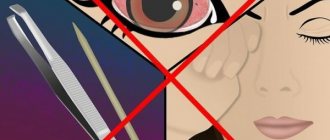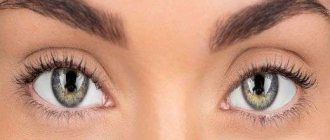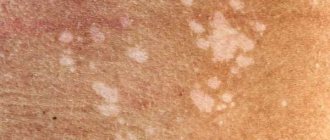Red eyes due to ARVI
One of the most common symptoms of an acute respiratory viral infection is redness of the eyes. Sometimes this leads to inflammatory processes, and in some cases it goes away as the disease progresses. However, red eyes during ARVI are not the most pleasant symptom, because a person may develop conjunctivitis or other serious inflammation, which will lead to undesirable consequences. There are certain methods for treating this phenomenon, but you shouldn’t get ahead of yourself right away, since we still have to analyze the causes of redness, the characteristics of this symptom, signs of pain in the eyes, and only after that will some recommendations be given on how to cope with the disease.
Conjunctivitis with coronavirus: does it happen or not?
Pain in the eyes, active lacrimation, redness and burning are signs characteristic of conjunctivitis of any known form. They often occur during acute respiratory infections and may be a sign of coronavirus. This is often the first sign of pathogen activity in the human body.
Attention!
According to statistics, about 30% of patients who recovered from COVID-19 complained to doctors about discomfort with vision. Often this problem persisted for a long time - up to 2 weeks.
Definitely, conjunctivitis can occur during coronavirus infection, and these are not exceptional cases. Everything is easily explained from a medical point of view. The pathogen enters the human body through mucous membranes, including through the eyes. That is why the general recommendations for preventing the spread of COVID-19 clearly state that you should not touch your face with dirty hands.
Causes of redness
ARVIs are viral diseases, in other words, infections that affect the mucous membrane of the upper respiratory tract. The main symptoms of a cold are a runny nose, cough, and sore throat, but you can often find such a sign as redness of the eyes. With what it can be connected? There are several explanations for this phenomenon:
- Due to the action of pathogenic bacteria and viruses, inflammation of the mucous membrane of the eye occurs, which causes a feeling of dryness and a slight burning sensation.
- Conjunctivitis develops, the eyelids swell, lacrimation, constant itching and burning occur.
- Thus, some people have an individual reaction to ARVI.
- In some people, red eyes occur due to diseases of the internal organs. For example, a cold causes inflammation, after which the body sends signals to the central nervous system, which causes discomfort in a person’s eyes.
Only a professional doctor can correctly determine what caused the redness, so contact a specialist immediately to avoid making mistakes in treatment.
Associated symptoms
Redness of the eyes is accompanied by other symptoms: fever, runny nose, cough. If conjunctivitis is diagnosed, the patient may still experience profuse tears, a feeling of a foreign body in the eyes, and a feeling of glued eyelashes in the morning. But there can also be complications. If the eye flu has damaged the cornea, there may be pain, twitching of the eye and severe fever, requiring more serious treatment.
ARVI is also characterized by symptoms:
- sore throat;
- redness and sore throat;
- dry, intermittent cough with sputum;
- feelings of general intoxication.
Redness of the eyes appears only if a bacterial infection is associated with the disease. With eye flu, inflammation of the mucous membrane of the eyes (keratitis) may also occur. Severe forms of the disease are observed mainly only in the case of an epidemic of colds.
Soreness
During illness, the body is greatly weakened. The patient may feel lethargic, tired, and have sore eyes due to the spread of the virus in the body. Toxins even penetrate into the muscles of the body, weakening them. The mucous membrane of the nose swells, pain appears in the frontal part of the head and around the eyes.
Eye pain may include:
- like a sensation of a foreign body, sand;
- excessive dryness, causing itching;
- feeling of stickiness due to purulent discharge.
Migraines may worsen when turning or tilting the head. It is recommended to drink as much warm liquid as possible and take medications that reduce fever and treat a runny nose. During illness, pain may radiate to the head and some areas of the face (if the trigeminal nerve is affected).
Expert opinion
Kim Oksana Alexandrovna
Head of the ophthalmology clinic. Ophthalmologist with more than 10 years of experience.
In particularly difficult cases, headaches intensify with exacerbation of the disease and may be accompanied by nausea and vomiting. There may be dizziness and even loss of consciousness. The temperature during ARVI can rise to 38°C on the first day, but does not stay high for long.
Main features
Red eyes during ARVI are the main symptom, however, it is also accompanied by some other symptoms that you should pay attention to:
- A burning sensation in one or both eyes.
- Slight redness of the whites.
- Arbitrary secretion of tears when they roll out of the eyes without the person’s knowledge.
- Photophobia occurs because it is quite difficult to look at the light.
If you notice one or more of the above symptoms, you should seek medical help. After the examination, appropriate medications will be prescribed that will eliminate the redness and get rid of the viral infection.
Red eyes in a child
Don’t be too surprised if your child’s eyes turn red during a cold. Children's bodies are less protected and often cannot fight serious diseases on their own, as a result of which they very often develop conjunctivitis due to ARVI.
What happens as a result of the disease? The thin membrane covering the eye becomes inflamed and the eye membrane is affected. The result of all this is the appearance of a dried crust on the eyelids, gluing of these same eyelids, as well as a slight swelling, hypersensitivity to light.
Red eyes during ARVI in a child are not a rare symptom, but you cannot sit still, because the disease must be treated urgently. As a rule, with conjunctivitis, which occurs due to a cold, you will also encounter other symptoms: runny nose, cough, fever, etc.
Your task is to defeat the bacterial infection, to help the little man’s body overcome the virus that is firmly entrenched inside. For this, various children's drops, preparations and some traditional methods are used:
- Albucid solution. These are special antibacterial eye drops that are used for bacterial infections.
- Rinza and Rinzasip. An anti-cold remedy, the action of which is aimed at eliminating the main cause of pain in the eyes. After using the drug, nasal function improves, headaches go away, and lacrimation stops.
- Chamomile compress. This is a folk method that is absolutely safe, but most effective. This compress relieves eye irritation, soothes them, relieves burning and discomfort.
Before using anything to treat a child, be sure to consult with your doctor, as some children may have allergic reactions to this or that drug.
Causes of eye redness due to fever
Typically, redness of the eyes in children with an increase in temperature is observed with the development of the following diseases :
- adenovirus infection;
- flu;
- rhinitis;
- whooping cough
Adenovirus infection
This infection can occur in several forms, one of which is accompanied by damage to the mucous membrane of the eye and causes conjunctivitis.
Know! The disease begins with a sharp increase in temperature to 38-39 degrees. After this, the little patient experiences a sore throat, body aches, nasal congestion and red eyes.
It is worth noting that conjunctivitis caused by adenovirus has some features. Its main symptoms are:
- a burning sensation in the eye;
- swelling of the eyelids;
- tearing and purulent discharge from the eye ;
- the presence of a whitish coating.
The disease first affects one eye, and then moves to the second.
Flu
Redness of the eyes with the flu occurs on a completely different principle.
The fact is that the infection affects small vessels of the mucous membranes , including the eyes .
As a result , they begin to expand in order to increase blood flow. Enlarged vessels become clearly visible against the background of the eye sclera , and the eyes begin to appear red.
In addition, your child may experience the following symptoms:
- temperature rise to 38-40 degrees;
- body aches;
- nasal congestion;
- sore throat;
- photophobia and increased tearfulness.
Rhinitis
Red eyes with rhinitis are a common phenomenon associated with the physiological characteristics of the body.
It is worth noting! Inflammation from the nasal cavity often affects the mucous membrane of the eyes and is expressed in the form of conjunctivitis and increased tearing.
Usually, redness of the eyes is observed at the initial stage of the disease . In this case, the patient may experience accompanying symptoms such as:
- photophobia;
- itching;
- burning;
- formation of purulent discharge from the eyes.
In addition to everything, the patient experiences severe inconvenience associated with nasal congestion .
It is worth noting that allergic rhinitis has similar symptoms that resolve after taking antihistamines.
Whooping cough
A fairly serious disease that is accompanied by the following symptoms:
- slight increase in temperature;
- paroxysmal cough with wheezing and sputum production.
Keep in mind! Redness of the eyes due to the disease occurs due to increased pressure in the blood vessels, which is formed as a result of increased tension during an attack.
At the same time, during a cough, not only the eyes, but also the face turn red. Minor bruising may occur on the skin .
Redness treatment and prevention
Treatment must be approached responsibly, because many medications have their own contraindications and can have side effects. Contact a truly experienced specialist who will suggest the most effective treatment methods.
You can try the following medications to get rid of eye redness and viral infection due to ARVI:
- Visine is an eye drop that relieves eye irritation.
- Oxial - drops that reduce dry eyes and help restore damaged corneas.
- Khilozar-Chest of drawers. They are used for eye fatigue, as well as to moisturize them during dryness due to ARVI.
- Lavomax. The drug stimulates the production of interferons, which protect the human body from the penetration of viruses.
- Cycloferon. Has immunomodulatory and antiviral effects.
As a preventative measure, it is necessary to take medications that strengthen the human immune system; it is also worth limiting contact with people who are already sick with ARVI, not touching your eyes with dirty hands, and not rubbing them on the street when there is a high probability of viral infections entering the body.
Don’t be afraid of this phenomenon, just take the necessary measures in a timely manner, and then the redness of the eyes will quickly go away, and you will be able to recover as quickly as possible.
Archive number No. 7 (1061) dated February 10, 2020 - Zdoroviechko
SEASONAL
When the weather changes from plus to minus, there is no need to relax.
Dressed inappropriately for the season, overcooled - a cold was right there! And people are starting to get the flu. The diseases have similar symptoms, but the causes of their occurrence are different. [td]
Difference number 1.
The flu usually develops abruptly, while a cold develops more gradually over one to two days.
Difference number 2.
With the flu, high body temperature reaches 38.5–39 degrees. With a cold it is slightly lower - 37–38 degrees.
Difference number 3.
A cold leads to a long trail of symptoms: a runny nose appears, a person sneezes, his eyes water, and sometimes he has a sore throat. With the flu, such troubles are not of particular importance, but a dry cough, sore throat and sore throat are annoying. All this is supported by high body temperature.
Difference number 4.
If you feel chills and your body aches, there is no doubt that it is the flu. With a cold, such symptoms are also possible, but they are much less common.
Difference number 5.
With the flu, a headache is quite common. With a cold, there may be no pain at all, and if there is, it will be insignificant.
Difference number 6.
The flu causes severe weakness, and this condition can persist for almost two weeks. With a cold, a sick person also has little strength, but their decline is not felt so significantly and noticeably.
Difference number 7.
Flu is dangerous due to its complications:
— secondary bacterial infections (rhinitis, sinusitis, bronchitis, otitis, pneumonia);
- inflammatory diseases of the heart muscles, which can lead to heart failure;
- exacerbation of bronchial asthma, chronic bronchitis, cardiovascular diseases, metabolic disorders, kidney diseases, etc.
How to avoid getting the flu
Do you know how the influenza virus enters our body? You can become infected if a sick person sneezes or coughs and you are nearby. Moreover, from the moment of infection to the appearance of the first symptoms of the disease, it takes from several hours to several days.
To protect yourself from the disease, you should rest more, preferably in the fresh air, and drink plenty of fluids. And with the onset of cold weather, do not forget to dress warmly before going outside. Eat properly and nutritiously. Your body especially needs vitamins now. And most importantly, try to experience more positive emotions!
It's easy to catch the flu if you used the same thing as someone who was sick and didn't wash your hands with soap afterward. And this, by the way, is the most important procedure in preventing a dangerous virus. You can also get sick by frequently touching your eyes: a person doesn’t even notice how he does it dozens of times a day.
What else? Since a person with the flu is most contagious to others in the first 2-3 days, try to isolate him by sending him to another room. If this is not possible, isolate the sick relative from others with a thick sheet.
A person who has the flu should also have their own dishes, which after use should be kept in boiling water for at least 10 minutes each time. And after measuring your body temperature, do not be lazy to wipe the thermometer with vodka or alcohol.
If you ventilate the room where the patient is located several times a day, the number of pathogenic bacteria and viruses in the air will be significantly reduced. It is also important to do wet cleaning and turn on a lamp with ultraviolet light. All means are good in the fight against the virus.
During periods of illness, people with a high temperature have a rather difficult time withstanding the dry air in the house when the radiators are boiling with might and main. To humidify the air, place containers of water near the heaters.
Hang garlic beads at the patient's head. This will also protect others from the insidious virus.
Those who care for the sick should also take care of themselves. Don't skip the gauze bandage or mask. But they should be changed every four hours. The disposable mask can be thrown away, and the gauze bandage can be boiled or ironed with a hot iron and used again.
Wash your nose with soapy water, rinse your throat and mouth with a weak solution of soda, iodine and salt (for 1 liter of warm boiled water, take 1 tablespoon of soda, 1 tablespoon of salt, 30 drops of 5 percent iodine solution), lubricate nasal passages with oxolinic ointment three times a day.
If you get sick
If you still have a cold, first try to cope with the disease yourself:
- clear a stuffy nose, nasal sprays and salt water drops will help with this;
- inhale steam from any container with hot but not boiling water, covering your head with a towel. Add aromatic oils to the water or brew eucalyptus leaves; this method of treatment is good for those who do not suffer from allergies;
- gargle with warm salt water or with the addition of soda, you can use lozenges or throat lozenges;
- For pain relief, take paracetamol, ibuprofen or aspirin. Never give aspirin to children without a doctor's prescription! Vitamin C effectively fights colds and can speed up your recovery.
If your condition suddenly worsens, or the disease lasts longer and is more severe than usual, be sure to consult a doctor.
Many people, trying to cure themselves, start taking antibiotics. Do not do this unless prescribed by your doctor. Antibiotics have a detrimental effect only on bacteria and have no effect on viruses, so for ARVI and influenza they are useless and can only do harm.
RECIPES
Have a glass
To get rid of bronchitis overnight, pour 1 glass of dry white or red wine into a small enamel pan and put on fire.
Pour cinnamon into it at the tip of a knife, add lemon or orange zest, cloves, oregano or lemon balm, and one bay leaf. When the wine begins to boil, remove it from the heat and strain. Add 1 tbsp. l. honey, mix well and drink hot. After this, go straight to bed, putting on warm socks and wrapping a warm scarf or handkerchief around your throat and chest.
Ginger attack
Ginger tea quickly cures colds: 1/4 tsp. pour ginger powder or finely grated fresh root into a glass of boiling water, add sugar or jam.
Drink the drink slowly. After an hour and a half, repeat the treatment. An incipient runny nose will disappear after a couple of glasses, and a cough - after a maximum of six.
Natalya INVIDIMOUS
Share link:
Subscribe to “For Each Other”:
Yandex News Yandex Zen Google News YouTube Video
Causes
A cold affects the upper respiratory tract. Cough, sore throat, snot, and red eyes are observed. Bacteria can get into the eyes during strong wind, cold, or draft.
Important! ARVI is a viral disease.
Why are young children very often at risk of developing pathology? Unlike an adult, a child’s body has not fully developed immunity.
The main causes of the disease:
- As a result of pathogenic microorganisms entering the eye, inflammation occurs. It is accompanied by burning and dry eyes.
- With flu and colds, the risk of developing viral conjunctivitis will increase. The disease is accompanied by itching, burning, and lacrimation.
- Individual reaction of the body to a cold.
- Diseases of internal organs.
- Intoxication of the body.
- Inflammatory process.
Prolonged exposure to air at sub-zero temperatures and a decrease in the body’s protective abilities can provoke the occurrence of pathology.
Symptoms
The development of influenza and colds is accompanied by the appearance of redness of the eyes.
Important! Orz can develop in both adults and children.
As a result of inflammation of the conjunctiva of the eye, painful sensations occur in bright light, during prolonged work at the computer. The inflammation initially affects one eye, then an infection occurs in the healthy organ of vision.
Characteristic symptoms are:
- elevated temperature;
- itching, burning, pain in the eyes;
- purulent, mucous discharge;
- fear of bright lighting;
- activation of tear production;
- feeling of the presence of a foreign body;
- swelling;
- eyelashes sticking together after sleep;
- inflammation of the whites of the eyes.
The development of acute respiratory diseases may be accompanied by:
- headache;
- fever, chills;
- sore throat;
- cough.
The intensity of eye redness during flu and colds depends on body temperature. The higher it is, the more intense the disease develops.
Important! The temperature stabilizes as the person recovers.
Symptoms of conjunctivitis with coronavirus
The general clinical picture of inflammatory eye pathology includes the following symptoms:
- redness of the white of the eye;
- sensitivity to sunlight;
- lacrimation;
- pain in the eyes;
- blurred vision, slight decrease in visual acuity;
- the appearance of spots and spots before the eyes.
Attention!
Against the background of a viral infection and a decrease in the ability of the immune system to repel viral attacks, purulent discharge may appear.
The listed symptoms are typical for conjunctivitis, and their appearance is explained by damage to the retina and optic nerve. Ophthalmologists say that a decrease in visual acuity should not be a cause for panic. This often occurs due to changes in tear composition, muscle spasms, and swelling. These changes disappear without additional intervention after recovery.
Treatment
Why should you consult a specialist if you experience characteristic signs of eye damage due to influenza? He will determine the cause of inflammation of the visual organs and prescribe treatment.
The answer to the question of what to do when signs of conjunctivitis appear against the background of a cold is complex therapy. It consists of the parallel use of eye drops, ointments, anti-inflammatory, antibacterial, and antipyretic agents.
The following will help eliminate red eyes due to a cold:
- eye drops: Visin, Oksial, Khilozar-Komod;
- antibacterial eye ointments: Ciprofloxacin, Ofloxacin, Oxolinic, Tebrophenic;
- antiviral drugs: Oftalmoferon;
- anti-inflammatory drugs: 0.1% solution of Diclofenac sodium;
- tear replacement therapy: Oftagel, Systane.
Immunomodulators and vitamin complexes will help speed up the healing process and strengthen the immune system in adults and children.
To cleanse the eyes of purulent discharge in the viral form of conjunctivitis, use a solution of Furacilin, a decoction of chamomile.
Untimely treatment can lead to the development of various diseases: tonsillitis, keratitis, otitis media, bronchitis.
Important! In severe forms of the disease, laser stimulation, magnetic therapy, and keratoplasty are used.
How to treat an adult
To remove redness and swelling of the eyes, you must first eliminate the cause of the disease. For this purpose, medications and other means are used: etiotropic and pathogenetic drugs that affect the virus or block enzyme systems that allow it to multiply. At the same time, eye drops and other medications are used to alleviate negative symptoms in the eye area.
For treatment you need:
- disinfect hands;
- lie down in a horizontal position and let the drops drop into your eyes or do it yourself.
To treat viral eye diseases, recombinant interferon eye drops are required. In addition to interferon, the drug contains the antiallergic drug diphenhydramine, which reduces swelling and itching. You need to instill 1-2 drops of the drug into each eye up to 6-8 times a day.
For bacterial conjunctivitis, broad-spectrum antibiotics are used (in the form of eye drops and ointments). When instilling eye drops, you need to pull back the lower eyelid and use your other hand to drip in the drops. Redness of the eyes does not require special treatment other than rinsing with a solution or drops. In a couple of days, immunity is developed, and the body is able to cope with inflammation on its own.
Vasoconstrictor drops with an alpha-adrenergic agonist narrow the capillaries of the sclera and conjunctiva. The drugs are used for conjunctivitis of various origins and inflammation of the eye mucosa during colds. If the cause is blepharitis, then apply warm compresses.
General principles of therapy
Umifenovir, oseltamivir and zanamivir are used for treatment, which are preferably used within the first two days from the onset of the disease. Etiotropic therapy shortens the duration of the disease, removes symptoms, and prevents the development of complications such as pneumonia, bronchitis, otitis and others. It is better to stay in bed and stay in an isolated room.
Basic principles of treatment:
- use of antibacterial therapy;
- antipyretic therapy when body temperature rises above 38.2-38.5 “C;
- rinsing and applying eye drops to reduce redness and swelling;
- the use of drugs to enhance immunity;
- prevention of complications.
In order for the immune system to join the fight against the disease, drugs are also used that enhance the production of interferons (Tiloron (Amiksin), Kagocel) or activate immune cells-phagocytes. In the acute period, arbidol, aflubin, edas, herbal immunomodulators (echinacea, eleutherococcus), etc. are also used. To reduce redness of the eyes, instill 1 drop into each conjunctival sac 3 times a day, no more than 7-10 days.
Against the background of ARVI, an allergy may also appear, resulting in redness of the sclera. In this case, topical medications (drops) are used. Sometimes steroid eye drops are also prescribed. In the absence of proper treatment, serious complications can develop (otitis media, sinusitis, tonsillitis, etc.). To reduce the symptoms of intoxication, it is advisable to drink more and move less.
Complications
Incorrect, untimely treatment of an eye disease against the background of influenza can provoke the development of various complications.
Keratitis
An eye disease is an inflammatory process of the cornea. There is clouding and disturbances in optical function. Keratitis occurs against the background of conjunctivitis. The characteristic symptoms of the disease are:
- redness of the eyes;
- pain syndrome;
- fear of bright light;
- lacrimation;
- visual impairment.
Prevention
Preventive measures will help speed up the recovery process of the pathology that arose against the background of a cold or flu.
- Hygiene rules. After visiting public places, as well as contact with pets, you must wash your hands with soap. You cannot use someone else's towel or bed linen. Residential premises should be cleaned regularly.
- Observe hygiene rules when performing medicinal procedures. Use sterile cotton wool and bandage. Before instillation, the eyes must be cleaned by rinsing. Use separate accessories to treat both eyes.
- Strengthening the immune system. You can activate the body's protective abilities through sports: running, race walking, swimming, fitness, yoga.
- Timely treatment of viral, colds and infectious diseases.
- Proper nutrition. Food is a source of vitamins and microelements. Your daily diet should include vegetables, fruits, dietary meat, and seafood. You should avoid fatty, smoked foods and soda.
When the first signs of an eye disease appear, you should consult a doctor.
Important! You cannot treat yourself.
Untimely treatment causes damage to the structure of the eyeball and loss of vision.
What is eye flu?
According to media reports and German doctors, cases of infection with a new virus, which has already been dubbed eye flu, are becoming increasingly common in Germany. An eye flu epidemic was already noted in 2016 in Bonn. Even then it became clear that the problem was serious, because no antibiotics had any effect on the patients. The consequence of this pathology was an outbreak of diseases of the respiratory system and gastrointestinal tract.
However, the causative agents of the disease have not yet been studied. There is also no adequate therapy. Now the only thing that experts can talk about with confidence is methods of preventing infection. So what is eye flu and how to deal with it?
What are the symptoms of eye flu?
As experts from the Federal Center for Health Education in Germany note, in its first symptoms, eye flu is very similar to standard conjunctivitis. First, there is redness in one eye, then swelling appears in the other. It may feel as if there is some kind of foreign body under the eyelid. As the disease progresses, severe itching in the eyes occurs and sensitivity to light is noted.
The incubation period after infection is 5-12 days. And as soon as the first signs of the disease appear, a person can be called infectious to others. Doctors call eye flu insidious because it is resistant to drugs and is also considered highly contagious (that is, it is very easy to become infected with it). In addition, it is characterized by a long duration of complications - for example, many who have had the infection complain of “cloudness” in their eyes for several more weeks. The only thing that can slightly alleviate a person’s condition, doctors say, is eye drops with cyclosporine.
Viral eye infections: types
There are several types of infectious pathologies in the visual system that can significantly worsen a person’s condition. Among them are the following options:
1. Adenoviral conjunctivitis - adenovirus is, in principle, one of the most common infections. When infected, redness of the membranes of the eyes, swelling of the eyelids, and the appearance of clear discharge from the eyes are noted. Your overall body temperature may even increase. With the membranous variant, a film may appear on the eye; with follicular conjunctivitis, a small rash may appear against the background of adenovirus.
Article on the topic
Glaucoma, cataracts, farsightedness. What eye diseases threaten after 40 years 2. Herpetic conjunctivitis - in this case, as a rule, one eye suffers. The disease proceeds rather sluggishly and for a long time; a follicular form is possible, in which there may also be blisters.
3. Epidemic keratoconjunctivitis is a disease with a fairly rapid spread in the group, first affecting one eye, then the second one is also involved. Among the manifestations are redness of the eyes, the appearance of lacrimation, and quite profusely. In addition, additional symptoms include a feeling of speck in the eye, the appearance of photophobia and an increase in temperature, which will be quite persistent.
4. Viral keratitis is an inflammation of the cornea of the eye, most often found in children and the elderly. Moreover, the pathology can be both superficial and deep, caused by adenoviruses, smallpox viruses, measles, etc. Triggers for such an infection can be hypothermia, decreased immunity and stress.
5. Viral uveitis - inflammation of different parts of the choroid of the eyes. This diagnosis is made, according to statistics, in half of the cases. The trigger for this pathology is various factors, for example it can be provoked by herpes. Symptoms include redness of the eyes, watery eyes, sensitivity to light, and loss of picture clarity.
6. Viral blepharitis - this eye disease leads to the sensation of a grain of sand getting into the eye. Because of this, blinking becomes more frequent, and the person also rubs his eyes, which further worsens his condition. Redness of the eyelids and rapid fatigue of the organ are noted. If blepharitis becomes severe, severe itching appears.
A viral eye infection, the symptoms of which are clearly visible, causes a lot of trouble for a person. Such pathologies reduce the quality of life and impair performance. And if you take into account the potential risks, it becomes clear that it is better not to delay treatment.
These eyes are opposite. What diseases can an ophthalmologist diagnose? More details
How is eye flu treated?
If treatment is started in a timely manner, the disease can last about a week; in some cases, recovery takes two weeks. Therapy includes a combination of medications - antipyretics, painkillers and local ones. Therapy must be carried out under the supervision of a doctor; there should be no independent attempts to cope with the problem, since delaying time can lead to loss of vision.











